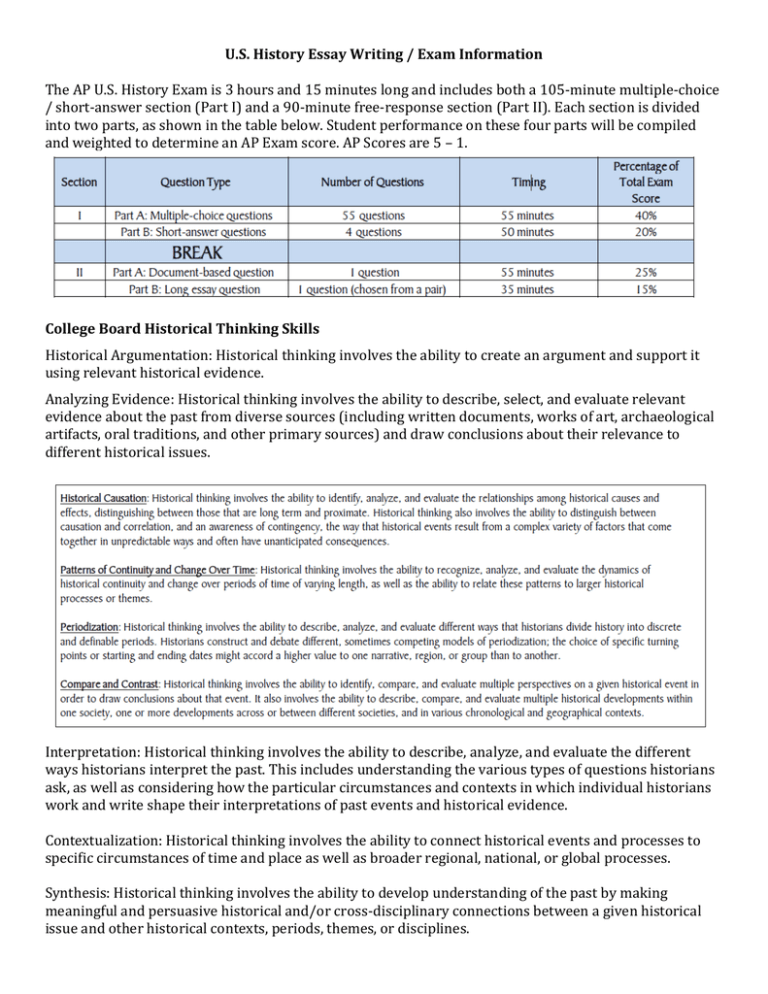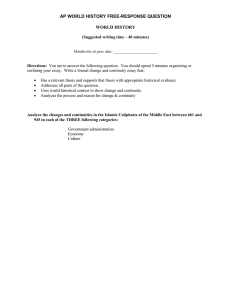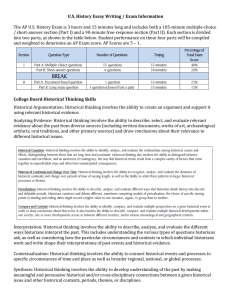U.S. History Essay Writing / Exam Information
advertisement

U.S. History Essay Writing / Exam Information The AP U.S. History Exam is 3 hours and 15 minutes long and includes both a 105-minute multiple-choice / short-answer section (Part I) and a 90-minute free-response section (Part II). Each section is divided into two parts, as shown in the table below. Student performance on these four parts will be compiled and weighted to determine an AP Exam score. AP Scores are 5 – 1. College Board Historical Thinking Skills Historical Argumentation: Historical thinking involves the ability to create an argument and support it using relevant historical evidence. Analyzing Evidence: Historical thinking involves the ability to describe, select, and evaluate relevant evidence about the past from diverse sources (including written documents, works of art, archaeological artifacts, oral traditions, and other primary sources) and draw conclusions about their relevance to different historical issues. Interpretation: Historical thinking involves the ability to describe, analyze, and evaluate the different ways historians interpret the past. This includes understanding the various types of questions historians ask, as well as considering how the particular circumstances and contexts in which individual historians work and write shape their interpretations of past events and historical evidence. Contextualization: Historical thinking involves the ability to connect historical events and processes to specific circumstances of time and place as well as broader regional, national, or global processes. Synthesis: Historical thinking involves the ability to develop understanding of the past by making meaningful and persuasive historical and/or cross-disciplinary connections between a given historical issue and other historical contexts, periods, themes, or disciplines. The Big Four Model Arch-Types 1. Historical Causation (Cause or Effect): CE Prompt: Evaluate the major causes which led to the development of a Second Industrial Revolution. Step One: Organize the causes around three Themes or Categories (connect to the Learning Objectives). Step Two: Rank or prioritize the categorized causes in order of importance, determine the two major causes (*) and the one minor cause. Step Three: Within the body of your essay, you must address why these were the causes of the topic under investigation. Sample Essay Prompts: Evaluate the political, economic, and social reactions of Americans to the end of Reconstruction (1877). Explain how intellectual and religious movements impacted the development of colonial North America from 1607 to 1776. Evaluate the causes and consequences of the growing opposition to slavery in the United States from 1776 to 1856. 2. Historical Continuity and Change Over Time: CCOT Prompt: Evaluate the extent to which US foreign policy goals contributed to maintaining continuity as well as fostered change from the end of WWI (1918) to the end of the Korean War (1953). Step One: Label start and stop dates on timeline. Step Two: Identify significant events (5-7) on the timeline, related to the topic. Step Three: Determine whether there was MORE continuity or change within the period. Step Four: Select three of the most significant of the events. Make sure you maintain the 2/1 ratio (e.g., if you are arguing there were more continuities, then you need 2 examples of that, for 1 change, or vice versa). Step Five: Within the body of your essay, you must address why there were continuities and changes. Sample Essay Prompts: Evaluate the extent to which the goals of Reconstruction (1865 – 1877) regarding African Americans were achieved by 1900. Be sure to address both continuities as well as changes during this time period. Evaluate the extent to which the goals of conservatives contributed to maintaining continuity as well as fostered change from the 1950s through the 1980s. Evaluate the extent to which American foreign policy contributed to maintaining continuity as well as fostered change with regard to United States involvement in world affairs from 1796 to 1823. 3. Historical Comparison (Compare and Contrast): CC Prompt: Compare and contrast the decades of the 1920s and the 1950s. Step One: Bisect your Venn diagram in half and organize the similarities and differences around two Themes or Categories (connect to the Learning Objectives). Step Two: Determine whether there are more similarities or differences between the 2 concepts. Step Three: Within the body of your essay, you must address why there are similarities and differences. Sample Essay Prompts: Compare and contrast domestic and foreign policy goals of conservatives in the 1950’s with conservatives in the 1980’s. Compare and contrast reactions of Americans to immigration in the 1840s-1850s with immigration in the 1910s-1920s. Compare and contrast goals and strategies of African American leaders in the 1890s-1920s with the goals and strategies of African American leaders in the 1950s-1960s. NOTE: You will probably NOT be given the categories, but sometimes you might. 4. Periodization (Turning Point): TP Prompt: Evaluate the extent to which the French and Indian War was a Turning Point with regard to American and British relations. Step One: Bisect your T-Chart in half and organize the boxes around two Themes or Categories (connect to the Learning Objectives). Step Two: Determine whether there is more evidence to support that it was (Y) or was not (N) a Turning Point. Step Three: Within the body of your essay, you must address the extent to which the event under investigation was a TP. Sample Essay Prompts: Evaluate the extent to which the Mexican American War was a Turning Point with regard to the expansion of Slavery in the United States. The Declaration of Independence was a Turning Point in American History. Support, Modify, or Refute this statement. NOTE: Limit your time frame before and after the event to 20 years. So for the FIW, 1754 to 1763 (only consider 1734 – 1783). The Thesis Statement – What Is It? The Thesis Formula: X. However, A and B. Therefore, Y. NOTE: These are not necessarily standalone sentences, they are concepts. ‘X’ represents the strongest point against your argument. We call this the counter-argument. ‘A and B’ represent the two strongest points for your argument. We call these your organization categories. ‘Y’ represents the position you will be taking – in other words, your stand on the prompt. Levels of Specificity / Developing a Summary Statement – How Much Do I Say? How much specificity to include in the Summary Statement should be a balancing act, on the one hand, you don’t want to be too general (Level Three Generalization), but on the other hand you don’t want to be too specific (Level One Specification). Let them know where you are going, but don’t give away all your information. We want the reader to keep reading! We will call the right amount of specificity Level Two Specificity. Consider the following prompt: Evaluate the extent to which the Articles of Confederation were effective in solving the problems that confronted the new nation. Level Three Thesis (not enough): The Articles of Confederation was successful as a first attempt at building a government. However, the Articles of Confederation was weak politically, socially, and economically. Therefore, the Articles of Confederation did not provide an effective answer to the problems facing the new nation. Level Two Thesis (just right): The Articles of Confederation created a well-organized system for dealing with newly acquired territories and providing a financial means to increase needed revenue. However, it established a loose confederation of states that lacked a sense of national unity, it created internal gridlock that failed to establish a system of checks and balances, and it created a government that did not have the powers to conduct basic governmental business. Therefore, the Articles of Confederation was not effective in solving many of the problems faced by the newly formed United States. Level One Thesis (too much): Under the Articles of Confederation, the Land Ordinance of 1785 and Northwest Ordinance of 1787 created a well-organized system for dealing with newly acquired territories and a plausible means to increase government revenue in a time in which the country was facing massive debt. However, it established a decentralized government with limited sovereignty, creating a league of friendship, with limited effectiveness; it was unable to foster any sense of nationalism; it contained a lack of leadership and a lack of independent judiciary; it lacked provisions for raising revenues and collecting taxes from the states, as well as failing to handle the abuses of paper money, with no control over interstate commerce; and could not protect the country from rebellions like Shays’ Rebellion. Therefore, the Articles of Confederation proved unable to handle the problems faced by the country after the American Revolution. Putting It All Together – What Are the X, A, B, and Y’s? Historical Causation: Identifies the causes / effects, the reasons for those causes / effects, and determines which was greater. X = least important cause or consequence, why A & B = most important causes / consequences, why, organized by categories Y = your assertion statement Continuity and Change over Time: Identifies the historical continuities and changes, the reasons for continuities and changes, and determines which was greater. X = continuity or change, your counter-argument A & B = continuity or change during the specified time period, organized around the events Y = your assertion statement Compare and Contrast: Identifies similarities and differences, the reasons for similarities and differences, and determines whether there are more similarities or differences. X = more similar or different, your counter-argument A & B = similarities or differences between the two things, why, organized by categories Y = your assertion statement Periodization | Turning Point: Identify reasons for and against it being a TP AND the extent to which it was or was not a TP. X = counter argument, why something was or was not a turning point A & B = argument, why something was a turning point, organized by categories Y = your assertion statement Synthesis (Other Context) – the Concluding Paragraph Make connections between a given historical issue and related developments in a different historical context, geographical area, period, or era, including the present. “Similar in Kind, but at a Different Time.” Ask yourself, what other period (SKDT) makes sense to compare it to? Think of it in terms of what would make sense on a Venn diagram? Would you compare the FIW to the passage of the 15th Amendment? No. The American Revolution? Yes. Would you compare the Market Revolution to the Publication of Uncle Tom’s Cabin? No. The 2nd Industrial Revolution? Yes. Once you find a good period, make two connections. You begin the synthesis point of the essay with the following. “The [topic of essay] can be compared to the earlier / later period of [synthesis topic] in two ways…” Then establish two common connections to the two periods. It would look like this: “The American Revolution can be compared to the later period of Southern Cession prior to the U.S. Civil War in two ways. First, both groups saw themselves fighting for what they perceived as injustices from a tyrannical government. Southerners viewed the injustices of the Northern government in the same light as the Americans viewed the British, so much so, they utilized many of the same points of the Declaration of Independence. Second, both groups invoked the Lockean social contract theory, which allowed the throwing off any government when it failed to meet the needs of its citizens as a natural right.” Contextualization (Broader Context) – the Concluding Paragraph Situate historical events, developments, or processes within the broader regional, national, or global context in which they occurred in order to draw conclusions about their relative significance. 1st: Situate the topic of the essay within the broad historical context of the time, then 2nd: draw a conclusion about the topic, why was this event so significant? It would look like this: “The broad context to which the American Revolution was a small part of, revolved around the attempts of the British Empire to maintain control over its colonies; this power struggle would determine the fate of the British as a leading world power. Both their financial and political institutions required the existence of these satellite colonies, taxes and raw materials were necessary requirements to maintain their position in the world. The need to maintain control over its colonies was an essential element to maintaining that world status, thus the American Revolution was not simply a minor rebellion within a tiny colony, but a much larger revolution which would lead ultimately to the downfall of the greatest nation in the world and would give birth to the next great world power.”

